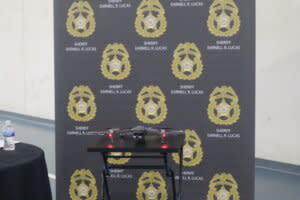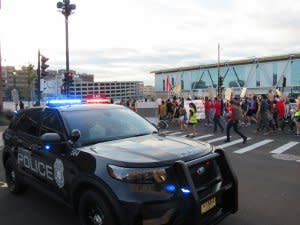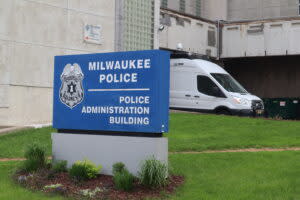Surveillance technology never left Milwaukee after the DNC

Protesters gather in small numbers during the 2020 Democratic National Convention (DNC). (Photo | Isiah Holmes)
In 2020, Milwaukee had high hopes that the Democratic National Convention would boost the local economy — then missed out when COVID-19 transformed the DNC into a mostly virtual event. While it didn’t attract tourists, the city was flooded with new gear for law enforcement in anticipation of the DNC. Much of that technology, including an expanded surveillance network, remains in Milwaukee as the city prepares to host the Republican National Convention (RNC) in July.
Emails obtained by the Wisconsin Examiner through open records requests reveal MPD’s efforts to expand its surveillance infrastructure, and how that expansion fueled tensions in local government.
The tides of change
Milwaukee in 2019 was a different place. Homicides were trending downward, MPD Capt. Alfonso Morales was promoted to chief, and a class action settlement mandated an end to racial profiling and stop-and-frisk practices by police. Milwaukee was also selected, for the first time ever, to host the DNC. Just 20 U.S. cities have hosted either the Democratic or Republican National Conventions. Even fewer — less than half since 1920 — have hosted both conventions.
Using a federal grant in 2019, MPD replaced its cell site simulator technology used to covertly track mobile phones. In addition, $50 million in federal money was provided for DNC security, including new equipment purchases for law enforcement. Local activists worried about the buildup, and also about new federal law enforcement operations launched in the months before and after the DNC.
As part of the run-up to the DNC, law enforcement agencies expanded surveillance systems and worked to integrate them across the city. Of central importance was growing Milwaukee’s camera network through DNC bid contracts.
MPD’s Fusion Center, according to a proposal document, oversaw that expansion. “The project will serve to increase the geographical reach/coverage and capability of the City of Milwaukee’s public safety camera system,” the document, dated May 19, 2020, states. “This request is for the purchase of equipment and technical engineering services to expand the City’s current coverage and capabilities, specifically to provide enhanced situational awareness before, during, and after the Democratic National Convention (DNC).”
Developed as a homeland security strategy after 9/11, fusion centers have many roles. MPD’s Fusion Division and the co-located Southeastern Threat Analysis Center (STAC) maintain a “Real-Time Event Center,” which “works to leverage a range of technology, law enforcement information, and regional partnerships to maximize law enforcement effectiveness in responding to, investigating, or deterring crimes,” the proposal document explains.
Prior to the DNC, according to an MPD spokesperson, there were 57 camera locations throughout Milwaukee. Most of the cameras could be turned to more than one angle, providing a total of 96 camera views. During the DNC in August 2020, the department reduced the number of locations by 14%, to 49, but increased the number of camera views by 37.5%, to 256. Older cameras were also replaced with new, multi-camera units.
MPD’s spokesperson said there did not appear to be a common council process to approve the camera network expansion. For the RNC, MPD has not expanded the number of cameras, but it has replaced some of them with more modern units, according to MPD’s spokesperson.
Drones, sensors and cameras everywhere
Fusion’s camera network can do more than just peer down roadways. Equipped with Automatic License Plate Recognition software, police create “hot lists” of plates they’re looking for, and the camera can then search for the plate and alert police when a target vehicle is sighted.
During and after the DNC, MPD undertook numerous projects to grow the Fusion Center’s reach. Those projects included integrating the city’s ShotSpotter network, which detects and triangulates gun fire using audio sensors, into larger systems; installing cameras into advertising platforms on Milwaukee’s “Hop” street car; and widening MPD’s visual access at the Fiserv Forum, Wisconsin Center and the Milwaukee Area Technical College. A Camera sharing agreement was established with the technical college, and another is now in the works for the Fiserv. The other proposed locations do not yet have agreements, an MPD spokesperson said. Fusion also explored agreements with Milwaukee County juvenile probation to obtain “GPS Offender Data” from the state Department of Corrections (DOC). An MPD spokesperson confirmed that a Memorandum of Understanding (MoU) does exist which allows “controlled access to GPS on a case-by-case basis.”
Ahead of the DNC, MPD also acquired new surveillance vans, which the department called “critical response vehicles.” Unmarked and painted solid white or black, crowned with antennas, the vans came equipped with myriad TV screens. In the back, a tethered drone rests on its own landing pad. Well before the convention, the vans were on the scene, monitoring George Floyd-inspired protesters as they marched through the city day and night. As the vans tracked the protests, Fusion personnel also monitored the streets through the city’s pole cameras. Fusion Center chat transcripts obtained by Wisconsin Examiner repeatedly mention the use of pole cameras to provide real-time updates on protest activity.
MPD’s drone capabilities, however, were not robust enough for some within the Fusion Center. Emails show that Fusion supervisors, bemoaning MPD’s tethered drones, envisioned “a drone that could stay up for hours at a time” and mused that with better drones, “upon ShotSpotter activation a drone would deploy to the area and record possible criminal activity.” Drones could aid the bomb squad, and participate in vehicle pursuits or locate suspects. “It’s a good thing because we had to beg and borrow for drone support during the riots which our chief did not like,” Lt. Branko Stojsavljevic, then-director of the Fusion-linked STAC unit, wrote in an email on June 11, 2020. “So we need to move forward with drones.” An MPD spokesperson said that the department does not have drones at this time.
Wisconsin Examiner separately obtained records from the state’s Homeland Security Council mentioning “STAC Clear Facial Recognition.” A PowerPoint presentation slide states, “This mobile device will allow Law Enforcement to conduct timely identification of individuals in the field to prevent terrorist attack.” Powered by Artificial Intelligence (AI), Clear Facial Recognition is a growing and controversial technology. Some cities have banned it, and in at least one case of police misconduct an officer used Clear to conduct surveillance with no clear law enforcement purpose.
Extracted pages from 2nd_Request
A spokesperson said MPD does not use facial recognition software. Earlier this year, MPD Chief Jeffrey Norman, responding to questions about the STAC’s Predictive Intelligence Unit, warned that AI being used by and against law enforcement is a growing concern.
Advances in surveillance technology have increasingly worried privacy advocates. “We have watched with concern as the city has installed new cameras, urged private property owners to share their camera feeds, and looked for other ways to surveil and monitor what is happening in public spaces,” said Tim Muth, staff attorney at the American Civil Liberties Union (ACLU) of Wisconsin, in a statement to Wisconsin Examiner. “This has largely happened because our city officials have failed to exercise their responsibilities to monitor the growth of the surveillance regime and have allowed for the integration of these surveillance technologies with AI without public transparency.”
Trouble along the road to the DNC
One Fusion effort that did not pan out was the intelligence center’s goal of gaining real-time access to Milwaukee county bus cameras. Doing that would turn county buses routed through neighborhoods into mobile eyes for Fusion.
“Obviously, this is a much more sensitive topic now, and we don’t have the ability to tie it to DNC,” Daniel Boehm, then-president and managing director of the Milwaukee County Transit Service (MCTS), wrote in a late June 2020 email to MCTS director of Safety, Security, and Risk Management Julie Schneider.
Boehm wrote that he would have to discuss the subject with David Crowley, then the newly elected Milwaukee County executive, “given the sensitivities around all things ‘policing’ right now.” Boehm retired in 2023 amid misconduct allegations after leading MCTS since 2014.
Crowley’s spokesperson told Wisconsin Examiner recently, “The Fusion Center does not, nor have they ever had direct access to the MCTS camera system. This access will not be offered during the Republican National Convention.” MCTS and MPD also said video access never materialized.
“MCTS was looking at ways to free up MCTS staff time that was dedicated to fulfilling video requests,” said MCTS Marketing and Communications Manager Anna Schryver. “Any sharing of MCTS video related to the RNC, or otherwise, would continue to be done by MCTS and under the supervision of MCTS as it is today.” Schryver didn’t know whether the Milwaukee County Board of Supervisors was ever informed of these talks.
A system called LiveEarth would have facilitated MPD’s bus camera access. LiveEarth was intended to combine multiple surveillance systems into one. Emails show that the proposed integrated system would include Shotspotter, pole cameras, business-owned IP cameras and mapping systems, with plans to add city alarm systems and expand camera access to Summerfest, Marquette PD, the Wisconsin Center, Fiserv Forum and city Housing Authority properties. “We do have limited access to cameras under the purview of the Housing Authority,” an MPD spokesperson told Wisconsin Examiner.
LiveEarth fell short of what MPD wanted, however. It couldn’t provide live video, and GPS data it relayed was spotty. Speaking about the scuttled efforts to integrate the buses, an MPD spokesperson said, “We are no longer exploring integration but we do have the ability to obtain video depicting criminal offenses.”
Fusion also wanted to feed UW-Milwaukee cameras into LiveEarth. A list of Fusion projects from late 2020 noted that “city fiber is available and awaiting connection details. Post DNC. Project remains in pending status. UWM has expressed a tentative willingness.”
Angelica Duria, communications director for UW-Milwaukee, disputed the suggestion that the university agreed to participate in the police surveillance plan, saying that “it is unknown why MPD wrote that and UWM is unaware of any such sentiment.”
A UW-Milwaukee records custodian at the university was also unable to find any trace of these talks. An MPD spokesperson said, “There were meetings between both organizations but no agreement was reached related to camera access. I cannot speak to why this project did not advance.”
Perception, deception and politics
While the DNC was reduced to a shadow of what planners had once envisioned, police officials fought to preserve their new equipment orders. In one email sent to city purchasing staff on June 26, 2020, MPD Lt. Wessam Yaghnam argued that the camera project couldn’t shrink because there was “no credible intelligence” indicating that non-local “agitators or protesters” wouldn’t disrupt the DNC. In another email, pushing for van rentals, Yaghnam wrote, “I understand the scope of the DNC has been altered, but that didn’t alter the platform this event provides. We have not been provided credible intelligence, which indicates that protestors are not coming to our event, but we are following chatter of the exact opposite, and we as the lead law enforcement agency have to understandably be prepared to handle situation that would arise.”
As it turned out, protests directly related to the DNC were sparse. During the nighttime hours, activists from Extinction Rebellion posted climate crisis fliers around the convention grounds. The Black String Triage Ensemble played mournful songs into the night, while police stood behind the DNC’s black security gate looking bored. The Coalition to March on the DNC held a daytime rally and march without incident. Many of those same activists are now suing the city to allow a similar march to be held “within sight and sound” of the RNC.
Meanwhile, MPD used the DNC’s downsizing to justify ditching troubled equipment. Lt. Stojsavljevic wrote that the LiveEarth system had trouble integrating with squad computer systems and camera surveillance. “Our intention was to wait until the DNC is over to start the process of terminating this contract,” Stojsavljevic wrote of the project, which cost the city $26,000 a year with a total cost of $545,000, according to his email.
Citing the “latest shrinking of the DNC,” Stojsavljevic wrote in an email shortly after the convention ended, “this would be a perfect opportunity to examine options to cancel the Live Earth contract for cause or convenience and save some money from that fund for another project.”
An MPD spokesperson told Wisconsin Examiner that LiveEarth’s contract ended because it did not “provide the hoped for functionality.” Today, MPD uses “a different solution” to integrate cameras as part of Community Connect Milwaukee, including a private agreement with the Milwaukee Bucks, which was finalized in May. According to the program’s website, over 1,100 cameras are registered to the program, with 554 listed as “integrated.” Stojsavljevic retired from MPD in 2022 amidst multiple misconduct investigations.
Operation Greenlight remains active on Milwaukee’s Villard Avenue, with no plans to expand. It is now part of Community Connect Milwaukee. An MPD spokesperson added that “both have led to successful prosecutions,” and that the downtown’ network is “an important tool in the prevention and solving of crimes in the downtown entertainment district.” Ald. Ashanti Hamilton, who’s mentioned throughout emails about Operation Greenlight, later left the common council and was appointed to head Milwaukee’s Office of Violence Prevention in 2022 by the mayor’s office.
The DNC’s downsizing also slowed a plan to upgrade computers and software in an “Emergency Operations Center” (ECO). The MPD and other agencies activate the EOC only for specific situations, including civil unrest, natural disasters or major political events like the DNC or RNC. The EOC computer project “was sponsored by the DNC task force” city IT specialist Pete Gnas wrote in an email to then-MPD Fusion Sgt. Adam Grochowski in October 2020. Gnas added that “due to the reduced DNC footprint this project was suspended while DNC staff coordinated with the [federal Bureau of Justice Assistance] on what projects would be permissible.”
Citizen groups push back
Oversight of surveillance technology and operations is a growing concern for privacy experts.
“Too often, police and other government agencies unleash invasive surveillance technologies on the streets of our communities, based on the unilateral and secret decisions of agency executives, after hearing from no one except corporate sales agents, ” said ACLU policy analyst Jon McCray Jones in a statement to Wisconsin Examiner. “This spy tech causes false arrests, disparately burdens BIPOC communities, immigrants, working-class people and invades our privacy, and deters our free speech.”
The ACLU is calling for the passage of Community Control Over Police Surveillance (CCOPS) ordinances in Milwaukee. Other communities, including the City of Madison, have either passed or are exploring passage of CCOPS. This would mean all existing and future surveillance gear used by the police would require public hearings, annual reports, and ultimately public approval. “These are basic accountability questions that law enforcement continuously avoids answering, but the community is entitled to those answers,” said McCray Jones.
Not long ago, the ACLU called attention to the MPD’s effort to acquire an “open source intelligence tool” ahead of the RNC. The technology would automate social media surveillance and be used to detect threats to the convention. In 2020, social media provided a wealth of information about protesters and activist events for law enforcement intelligence units, including Fusion. Muth cautioned that the open source intelligence tool purchased for the RNC will remain in Milwaukee once the convention ends, and may get integrated into MPD’s wider surveillance network.
“Over the past couple years we have witnessed mass surveillance technologies become weaponized against Black community leaders, protesters, activists, romantic interests of police officers, and women seeking abortions,” said McCray Jones. “These surveillance technologies are not only a threat to our individual privacy and freedom but to our democracy as a whole.”
GET THE MORNING HEADLINES DELIVERED TO YOUR INBOX
The post Surveillance technology never left Milwaukee after the DNC appeared first on Wisconsin Examiner.






